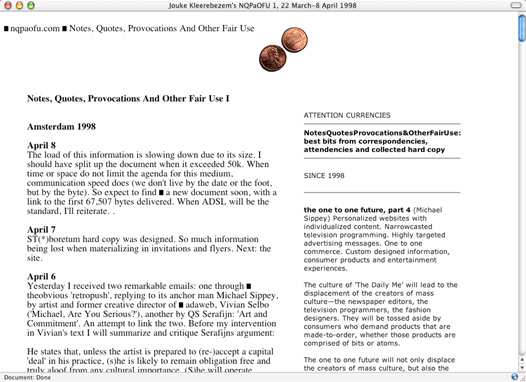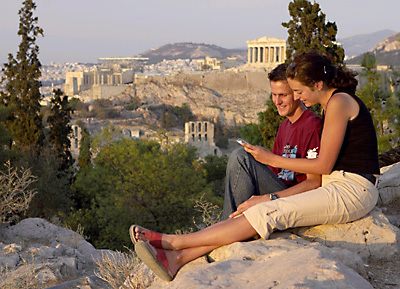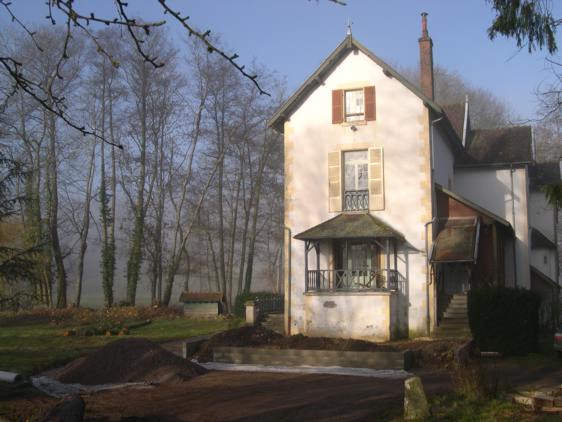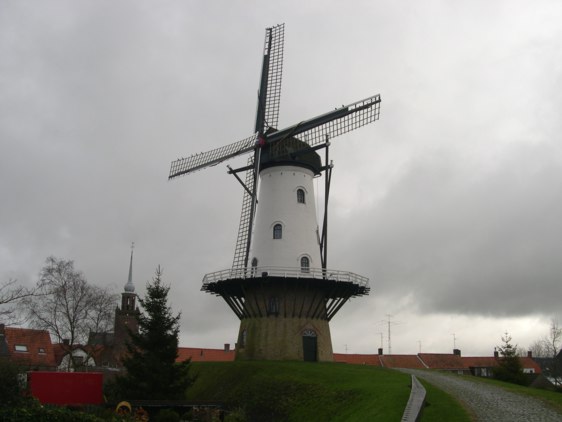|
mediatization/informatization

If someone could explain me the difference between informatization and informationalization s/he’d be welcome to let me know. Until today I by default use the latter but SpellWeb/Google puts me in the wrong at a 10.500/1.240 score. Meanwhile an excerpt from the soon to be published in print by Open#8 (available in a Dutch and English separate edition, get your copy) and soon to be posted here in its entirety The post-monumental image deals with what I see as the two major operations at work in today’s communication media and commercial/cultural production: mediatization and informatization.
(translation by Pierre Bouvier, courtesy Open Cahier) [bracketed parts in red do not appear in the original text]
In mediatization traditional ideas about collectivity and identity [the mass, the people, collective identity, cultural integration, the institution, the nation] invite an incessant mobilization of as large an audience as possible [the mass market, industrial production, commodification, consumption]. In informatization the fragmentation of collectivity and identity into infinite sub-interests [individual preferences, iEverything, ...] leads to new forms of interest promotion and social interaction. The difference between mediatization and informatization is not one separating different technological media. It is not a conflict between old and new media, or between analogue and digital production processes. [both mediatization and informatization can be located in their real everyday mechanisms and effects as well as in their fantastic rhetorical exaggerations in (popular) media]
mediatization
We can observe the result of the mediatization process most clearly in the popular press and on television. The mass media seem to constitute a last social ‘institution’ that can be understood in traditional terms. However, they do not exhibit the principle of solidarity based on an ideological canon that characterized traditional organizations and movements: we do not become members in them. Therefore we would do better to consider the popular media as an aggregate rather than as a directional force, as a medium, a vehicle that holds disparate elements in a loosely relational context.
But the most significant aspect of mediatization is the endless expansion of the public realm, for the preservation of the media’s own industry. What is private is dramatized and what is public is individualized. Both in entertainment and in ‘more serious’ genres, television is the quintessential mass medium, with ‘content’ for and by a mass audience. On what is still the most popular medium, mediatization brings everything to our attention, without distinction as to the person, without distinction as to the quality of the content, without distinction as to the value of the exhibited knowledge, and without a response from the viewer, who on the other hand is increasingly thematized and presented as part of the offerings, in the dramatic banality of his or her everyday existence.
informatization
Informatization is a substantially different project, although, due to technological and commercial developments, parallels can be drawn with mediatization. Informatization
outstrips mediatization in terms of technology and logistics at almost every level. The best model for studying informatization is of course the Internet.
It provides an unlimited supply of content and offers the consumer superior selection and navigation possibilities. ‘Network culture’ if we define it as the culture that could only emerge with the advent of the Internet is characterized by the free exchange of digitized content among individual interested parties, independent
of institutional intermediaries. The Net forms a platform in which every individual interest can be assured of a response and in which, thanks to the idealism of the first and second generation of Internet pioneers, an unparalleled amount and quality of cultural property is made available, free of charge. (...)
In order to avoid thinking of informatization as a primarily technological condition, we must concentrate on the characteristics in which it sets out its objectives,
those that distinguish it from mediatization. Informatization is geared not to the masses but to the individual. The network offers its infinite possibilities for the individual to identify him or herself in terms of his or her interests and then to search for the desired information, or to be addressed according to his or her individual knowledge and interests. Unless he or she deliberately presents him or herself as a member of a specific interest group, the network user cannot be addressed as such by other users of the network.
Informatization is also the lasting storage of ‘content’ data on ideas, people, and issues in the form of image, text and sound to be kept ready and delivered to any address, on demand and as desired. This requires no editorial intermediary; it suffices that the data I am looking for is stored at that moment in the network and earmarked in such a way as to be delivered at my request.
The information network can also mediate, however. In response to my request, data can be added to my ‘content’ by another network user. All transactions in the information network unfold thanks to an unlimited storage of data in endless configurations and thanks to selective access to these data. While it is often said that the network operates according to a process of ‘dis-intermediation’, the reality is that what is taking place is ‘pan-intermediation’.
The Internet has not been promoted in the way which it is described above. Only in its very early days we used to attribute such and even more idealistic possibilities to it. Some of its early believers have turned sour over the past decade. While there is all the reason to judge that mass media have taken over the network, to some extent it’s all on a wo/man’s mind. It is where you want to look in order to decide where you want to go and fight with these media. You do not want to battle the juggernauts (heheh... early jargon) but you can fight for diversity, alternative organisation, protest, explicit content and what have you... the entire heritage of a counter-cultural tradition, which was never aimed to install rule.
Its quality to ‘route around censorship’ is about the most optimistic qualification you can pick up these days in Internet critique. Be it already an amazing property, we need to say more and do more to maintain and improve net culture, to ‘take it to the street’ and oppose commodification, mediatization, digital consumerism. Heheh you’re telling me! Route around pessimism!
|
|






